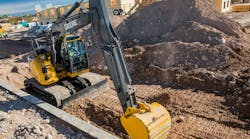The weak link in the emissions-control barrage unleashed by the 2014-15 Tier 4-Final machines is fuel. I predict fuel quality will put down more machines than faulty hardware or software.
We have been marching toward this point for over a decade, not fully understanding how the final emissions-regulating engines will affect fleet operation and management. Equipment managers know change is coming, but leasing, delaying and blind hope have them ill-prepared to manage the new fleets.
Two fuel-related issues must first be acknowledged, then understood, and finally, solved.
1) Fuel quality is the fleet’s responsibility, not the fuel vendor’s. Even today, the demand lags for fuel with the level of purity required for new engines. A vendor’s fuel truck may cover a 30-mile radius and fill only three machines that require pure fuel. The volume doesn’t exist to justify the expense of installing the filtration necessary to deliver clean fuel to on-site machines. One manager told me fuel filtration today is like using a window screen.
Let this anecdote illustrate. A vendor fueled a spread of earthmovers on a job, including two trucks and half a dozen pieces of iron. Within 30 minutes, all eight units were down. Fortunately for this fleet, the job could be brought back up with a simple fuel filter exchange. But it lost hours of productivity.
The person in charge of equipment and trucks is responsible for fuel. Until your vendor can deliver pure fuel (or until you find one that does), filtration must occur on the fleet side.
2) Diesel exhaust fluid, DEF, must be integrated into the fueling process. Machines that use SCR for emissions reduction require DEF, and the logical time to check and fill is when fuel is checked and filled.
Where will that DEF come from? Will it be on the fuel truck? Will it be stored in plastic jugs somewhere on the site? Will it be housed separate from fuel, doubling the amount of service time required?
The majority of fleets don’t have Tier 4 machines in the lineup yet. But don’t be fooled. The time to determine how you are going to fuel them and supply them with DEF is now, not when they’re working on a job site trying to produce money for your company.





